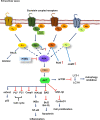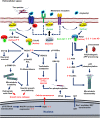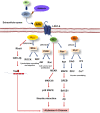G-protein coupled receptor, PI3K and Rho signaling pathways regulate the cascades of Tau and amyloid-β in Alzheimer's disease
- PMID: 35006431
- PMCID: PMC8607389
- DOI: 10.1186/s43556-021-00036-1
G-protein coupled receptor, PI3K and Rho signaling pathways regulate the cascades of Tau and amyloid-β in Alzheimer's disease
Abstract
Alzheimer's disease is a progressive neurodegenerative disease characterized by the presence of amyloid-β plaques in the extracellular environment and aggregates of Tau protein that forms neurofibrillary tangles (NFTs) in neuronal cells. Along with these pathological proteins, the disease shows neuroinflammation, neuronal death, impairment in the immune function of microglia and synaptic loss, which are mediated by several important signaling pathways. The PI3K/Akt-mediated survival-signaling pathway is activated by many receptors such as G-protein coupled receptors (GPCRs), triggering receptor expressed on myeloid cells 2 (TREM2), and lysophosphatidic acid (LPA) receptor. The signaling pathway not only increases the survival of neurons but also regulates inflammation, phagocytosis, cellular protection, Tau phosphorylation and Aβ secretion as well. In this review, we focused on receptors, which activate PI3K/Akt pathway and its potential to treat Alzheimer's disease. Among several membrane receptors, GPCRs are the major drug targets for therapy, and GPCR signaling pathways are altered during Alzheimer's disease. Several GPCRs are involved in the pathogenic progression, phosphorylation of Tau protein by activation of various cellular kinases and are involved in the amyloidogenic pathway of amyloid-β synthesis. Apart from various GPCR signaling pathways, GPCR regulating/ interacting proteins are involved in the pathogenesis of Alzheimer's disease. These include several small GTPases, Ras homolog enriched in brain, GPCR associated sorting proteins, β-arrestins, etc., that play a critical role in disease progression and has been elaborated in this review.
Keywords: Alzheimer’s disease; GPCR; LPA; PI3K/Akt; Rho GTPase; TREM2; Tau.
© 2021. The Author(s).
Conflict of interest statement
The authors declare that they have no competing interests.
Figures





Similar articles
-
TREM2 Inhibits Tau Hyperphosphorylation and Neuronal Apoptosis via the PI3K/Akt/GSK-3β Signaling Pathway In vivo and In vitro.Mol Neurobiol. 2023 May;60(5):2470-2485. doi: 10.1007/s12035-023-03217-x. Epub 2023 Jan 20. Mol Neurobiol. 2023. PMID: 36662361
-
The molecular bases of Alzheimer's disease and other neurodegenerative disorders.Arch Med Res. 2001 Sep-Oct;32(5):367-81. doi: 10.1016/s0188-4409(01)00316-2. Arch Med Res. 2001. PMID: 11578751 Review.
-
G-Protein Coupled Receptors and Tau-different Roles in Alzheimer's Disease.Neuroscience. 2020 Jul 1;438:198-214. doi: 10.1016/j.neuroscience.2020.04.019. Epub 2020 Apr 23. Neuroscience. 2020. PMID: 32335218 Review.
-
Role of TREM2 in Alzheimer's Disease and its Consequences on β- Amyloid, Tau and Neurofibrillary Tangles.Curr Alzheimer Res. 2019;16(13):1216-1229. doi: 10.2174/1567205016666190903102822. Curr Alzheimer Res. 2019. PMID: 31481003 Review.
-
G protein-coupled receptor kinases are associated with Alzheimer's disease pathology.Neuropathol Appl Neurobiol. 2021 Dec;47(7):942-957. doi: 10.1111/nan.12742. Epub 2021 Jul 19. Neuropathol Appl Neurobiol. 2021. PMID: 34164834 Free PMC article.
Cited by
-
Exploring bacterial metabolites in microbe-human host dialogue and their therapeutic potential in Alzheimer's diseases.Mol Divers. 2024 Nov 5. doi: 10.1007/s11030-024-11028-y. Online ahead of print. Mol Divers. 2024. PMID: 39499489
-
Synergistic activity of nootropic herbs as potent therapeutics for Alzheimer's disease: A cheminformatics, pharmacokinetics, and system pharmacology approach.J Alzheimers Dis Rep. 2024 Dec 23;8(1):1745-1762. doi: 10.1177/25424823241307019. eCollection 2024. J Alzheimers Dis Rep. 2024. PMID: 40034353 Free PMC article.
-
The Role and Mechanisms of G protein-coupled receptors in Parkinson's disease.Neurol Sci. 2025 Jun 11. doi: 10.1007/s10072-025-08260-1. Online ahead of print. Neurol Sci. 2025. PMID: 40500561 Review.
-
A p-Tyr42 RhoA Inhibitor Promotes the Regeneration of Human Corneal Endothelial Cells by Ameliorating Cellular Senescence.Antioxidants (Basel). 2023 May 30;12(6):1186. doi: 10.3390/antiox12061186. Antioxidants (Basel). 2023. PMID: 37371916 Free PMC article.
-
G protein-coupled receptors in neurodegenerative diseases and psychiatric disorders.Signal Transduct Target Ther. 2023 May 3;8(1):177. doi: 10.1038/s41392-023-01427-2. Signal Transduct Target Ther. 2023. PMID: 37137892 Free PMC article. Review.
References
-
- Cvetković-Dožić D, Skender-Gazibara M, Dožić S. Neuropathological hallmarks of Alzheimer's disease. Arch Oncol. 2001;9(3):195–199.
Publication types
Grants and funding
LinkOut - more resources
Full Text Sources
Miscellaneous
